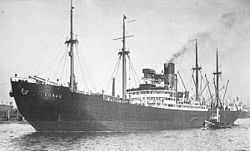Danube (ship, 1929)
|
M / S Danube
|
||||||||||||||||||||||
|
||||||||||||||||||||||
|
||||||||||||||||||||||
|
||||||||||||||||||||||
|
||||||||||||||||||||||
The Danube was a cargo ship of the shipping company Norddeutscher Lloyd (NDL).
During the Second World War , the ship was used as a transport ship between Germany and Norway . The ship is known because it was the largest deportation of Norwegian Jews .
Construction and equipment
The Danube was built by Deschimag at the Vulkan shipyard in Hamburg for the North German Lloyd in Bremen and completed in 1929 . She was the last completed four - masted express freighter of the NDL. In contrast to the ten four-masted cargo ships built previously, the bow and stern on the Danube and its sister ship Isar were designed in the Maier shape . As with the five freighters previously supplied by Deschimag companies with a triple expansion steam engine , this pair of ships also had an additional steam turbine . The tonnage of the ship was 9 025 GRT .
The Danube was requisitioned for military service by the command of the Kriegsmarine Dienststelle Hamburg and equipped with anti-aircraft weapons and depth charges. She was put into service to bring troops from the Eastern Front via Szczecin to Oslo and back.
Deportation of Jews
On November 26, 1942, 532 Norwegian Jews (302 men, 188 women and 42 children) were handed over to the SS by the Norwegian police under the direction of the Gestapo . The Jewish prisoners were deported to Stettin from Pier 1 of the Oslo port. The prisoners were under the command of Untersturmführer Klaus Grossmann and Oberleutnant Manig. The men and women were housed in separate holds on the ship, where basic sanitary conditions were lacking. The prisoners were mistreated by soldiers. After arriving in Stettin, the Norwegian Jews were transported from there by train to Auschwitz . 346 people were sent directly to the gas chamber . Only 186 men between the ages of 15 and 50 were classified as prisoners able to work and survived the arrival with the numbers 79064-79249 for forced labor to be performed . Only nine of the prisoners survived the Second World War . On February 25, another 158 Jews were shipped on the Danube to Stettin, brought to Auschwitz via the Berlin synagogue Levetzowstrasse assembly camp, and except for 28 men classified as fit for work were immediately murdered.
Damage and scrapping
The Danube was an important target of the Norwegian resistance movement as the ship was used at the end of the war to transport German troops to be used on the fronts, especially the Western Front . To prevent this, Roy Nielsen from the Milorg Resistance Movement and Max Manus from Linge Company installed ten detention mines 50 centimeters below the waterline along a 60 meter section of the ship's port side on January 16, 1945 or shortly before while it was in Oslo docked.
It was planned that the bombs should only detonate in the open sea after the Danube had left the Oslofjord . But because the ship's departure was delayed on the morning of January 17, 1945, the bombs exploded before the Danube had reached Drøbak , where the captain could still maneuver the ship onto the beach as it had not yet reached deep waters.
These events are depicted in the Norwegian feature film Max Manus from 2008.
The wreck was towed to Bremerhaven seven years later to be scrapped there, as a planned repair turned out to be too costly.
Individual evidence
- ↑ Schmelzkopf: Die deutsche Handelsschifffahrt 1919–1939 , p. 118
- ↑ http://www.theshipslist.com/ships/lines/nglloyd.shtml
- ↑ Ottosen, Kristian. "Overfarten". I slik en natt - historien om deportasjonen av jøder fra Norge (Norwegian). Oslo: Aschehoug. pp. 67-72. ISBN 82-03-26049-7 .
- ↑ Av Astrid Hygen Meyer. "Klassekampen: Aldri mer november 26th". Klassekampen.no. Retrieved July 16, 2012.
- ↑ Katja Happe u. a. (Ed.): The persecution and murder of the European Jews ... Vol. 12: Western and Northern Europe, June 1942–1945. Munich 2015, ISBN 978-3-486-71843-0 , p. 28.
- ↑ Ottosen (1994), p. 72
Web links
- The journey of the Danube (norw.)
- Operations of the Danube
- Operations of the Isar
- 532 jøder blew on board on the Danube. Bare 9 com tile beacon. norw. Article 70 years after the voyage of the Danube
literature
- Arnold Kludas : The History of German Passenger Shipping. Volume IV: Destruction and Rebirth 1914 to 1930. (Writings of the German Maritime Museum, Volume 21).
- Arnold Kludas: The ships of the North German Lloyd. Volume 1: 1857 to 1919. Koehlers Verlagsgesellschaft, Herford 1992, ISBN 3-7822-0524-3 .
- Arnold Kludas: The ships of the North German Lloyd. Volume 2: 1920 to 1970. Koehlers Verlagsgesellschaft, Herford 1992, ISBN 3-7822-0534-0 .
- Jürgen Rohwer , Gerhard Hümmelchen : Chronicle of the Naval War 1939-1945 , Manfred Pawlak VerlagsGmbH (Herrsching 1968), ISBN 3-88199-0097
- Reinhardt Schmelzkopf: German merchant shipping 1919–1939 . Verlag Gerhard Stalling, Oldenburg, ISBN 3 7979 1847 X .
